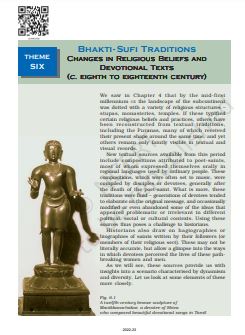‘Changes Religious Beliefs Devotional Texts NCERT Class 12 History Chapter 6 Solutions‘ PDF Quick download link is given at the bottom of this article. You can see the PDF demo, size of the PDF, page numbers, and direct download Free PDF of ‘Bhakti And Sufi Traditions Ncert Class 12 History Chapter 6 Exercise Solution’ using the download button.
Bhakti And Sufi Traditions NCERT Class 12 History Textbook Chapter 6 With Answer PDF Free Download

Chapter 6: Bhakti Sufi Traditions (Changes Religious Beliefs Devotional Texts)
Perhaps the most striking feature of this phase is the increasing visibility of a wide range of gods and goddesses in sculpture as well as in texts.
At one level, this indicates the continued and even extended worship of the major deities – Vishnu, Shiva, and the goddess – each of whom was visualized in a variety of forms.
Historians who have tried to understand these developments suggest that there were at least two processes at work. One was a process of disseminating Brahmanical ideas.
This is exemplified by the composition, compilation and preservation of Puranic texts in simple Sanskrit verse, explicitly meant to be accessible to women and Shudras, who were generally excluded from Vedic learning.
At the same time, there was a second process at work – that of the Brahmanas accepting and reworking the beliefs and practices of these and other social categories.
In fact, many beliefs and practices were shaped through a continuous dialogue between what sociologists have described as “great” Sanskritic Puranic traditions and “little” traditions throughout the land.
If you compare Fig. 6.2 with Fig. 4.26 (Chapter 4) you will notice that the deity is represented in a
very different way.
In this instance, a local deity, whose image was and continues to be made of wood by local tribal specialists, was recognized as a form of Vishnu. At the same time, Vishnu was visualized in a way that was very different from that in other parts of the country.
Such instances of integration are evident amongst goddess cults as well. Worship of the
goddess, often simply in the form of a stone smeared with ochre, was evidently widespread.
These local deities were often incorporated within the Puranic framework by providing them with an identity as a wife of the principal male deities – sometimes they were equated with Lakshmi, the wife of Vishnu, in other instances, with Parvati, the wife of Shiva.
Often associated with the goddess were forms of worship that were classified as Tantric.
Tantric practices were widespread in several parts of the subcontinent – they were open to women and men, and practitioners often ignored differences of caste and class within the ritual context.
Many of these ideas influenced Shaivism as well as Buddhism, especially in the eastern, northern and southern parts of the subcontinent.
All of these somewhat divergent and even disparate beliefs and practices would come to be classified as Hindu over the course of the next millennium. The divergence is perhaps most stark if we compare Vedic and Puranic traditions.
The principal deities of the Vedic pantheon, Agni, Indra, and Soma, become marginal figures, rarely visible in textual or visual representations.
And while we can catch a glimpse of Vishnu, Shiva and the goddess in Vedic mantras, these have little in common with the elaborate Puranic mythologies. However, in spite of these obvious discrepancies, the Vedas continued to be revered as authoritative.
Not surprisingly, there were sometimes conflicts as well – those who valued the Vedic tradition often condemned practices that went beyond the closely regulated contact with the divine through the performance of sacrifices or precisely chanted mantras. On the other hand those engaged in Tantric practices.
The traditions of devotion or bhakti need to be located within this context. Devotional worship had a long history of almost a thousand years before the period we are considering.
During this time, expressions of devotion ranged from the routine worship of deities within temples to ecstatic adoration where devotees attained a trance-like state.
The singing and chanting of devotional compositions were often a part of such modes of
worship. This was particularly true of the Vaishnava and Shaiva sects.
| Author | NCERT |
| Language | English |
| No. of Pages | 30 |
| PDF Size | 5.1 MB |
| Category | History |
| Source/Credits | ncert.nic.in |
NCERT Solutions Class 12 History Chapter 6 (Bhakti Sufi Traditions) Changes Religious Beliefs Devotional Texts
1. Explain with examples what historians mean by the integration of cults.
Ans: During the period of the 10th Century to the 17th Century, an important trend noticed in the religious life in India is the worship of God in many forms.
Many God and Goddesses appear in the sculptures and texts but they are various forms of the original deities only. These original deities are Vishnu, Shiva, and Goddesses Durga, Lakshmi, and Parvati.
Historians have noticed the two marked trends in the socio-religious life of those days. The first was the dissemination of the Brahminical ideas. The Brahminical texts were reproduced in simple Sanskrit.
They were now made available to women and Shudras, who did not have access to Brahminical literature by and large. The second was the Brahmins who were working on the beliefs and practices.
It was a process of evolution, wherein traditional classical traditions were getting new shapes continuously as they were being impacted by the traditions of common people throughout the land.
Now let us look at the two of the following examples.
1.A very good example of the above description is the temple of Jagannatha at Puri
in Orissa. The temple is of Lord Jagannatha who is another form of Vishnu only. The word Jagannatha means one who owns the world.
2. There were many local gods; their statues were often created by wood and stones by tribals. Even families began to have Kul Devata. The Goddesses were also created in wood and stone. They all were in various forms only often of Vishnu.
2. To what extent do you think the architecture of mosques in the subcontinent reflects a combination of universal ideals and local traditions?
Ans: The architecture of mosques in the subcontinent reflects a combination of universal ideals and local traditions in a significant way.
Some architectural features of mosques are universal – such as their orientation toward Mecca, evident in the placement of the mihrab (prayer niche) and the minbar (pulpit). However, there are variations in roofs and building materials.
For example, a mosque in Kerala (c. thirteenth century) has a shikhara-like roof. Atiya mosque in Mymensingh district, Bangladesh was built with brick.
The Shah Hamadan mosque in Srinagar, on the banks of Jhelum, is often regarded as the “jewel in the crown” of all the existing mosques of Kashmir were built in 1395.
It is one of the best examples of Kashmiri wooden architecture. It has a spire and beautifully carved eaves. It is decorated with papier mache.
3. What were the similarities and differences between the be-shari‘a and ba-shari‘a sufi traditions?
Ans: Shari’a is the Islamic law that is applied in a truly Islamic country. The Shari’a law owes its origin to the Holy book of the Quran, Hadis (Lawbook of Islam), and the teachings of Prophet Muhammad.
In the medieval ages, the Islamic world witnessed a big social and religious movement called the Sufi movement. The sufi movement was people-centric and not God-centric. It believed serving people was the real form of worship.
The sufi movement has had many branches too. One group of Sufi preachers took very radical path. They were mystics who renounced the material world and took to the life of asceticism. Further they also rejected the supremacy of the Shari’a laws. Such Sufis were called be-shari‘a.
On the other hand, there were sufi saints who criticized the extravagant lifestyle of monarchs and Khaliphates but did not reject Shari’a laws. For them Shari’a laws were sacrosant. These Sufi saints have been called be-shari‘a.
4. Discuss the ways in which the Alvars, Nayanars, and Virashaivas expressed critiques of the caste system.
Ans: The early Bhakti Movement was led by Alvars and Nayanars. It was the period of the 6th Century. Alvars are those who were disciples of Vishnu and Nayanars were those who claimed themselves the followers of Lord Shiva.
They traveled from place to place and would sing devotional songs in Tamil in the name of Shiva or Vishnu as the case may be. Apart from being a religious movement, it was a social movement too.
Many historians are of the view that Alvars and Nayanars gave a blow to the caste system and Brahminism. This is corroborated by the fact that the movement was open to people from diverse backgrounds.
The Bhaktas came from the castes of Brahmin to artisans to even those that were considered untouchables.
Virashaivas was a movement of the 12th Century that took place in Karnataka. The movement was led by a Brahmin named Basavanna (1106-68), who was a minister in the court of the Chalukya king.
The followers of Basavanna are called Virashaivas and they worshipped Shiv. They were also called and perhaps more often Lingayats, which literary means wearer of Lingas.
They challenged the caste system and they challenged the idea of any caste being a pollutant. This helped them grow support among marginalized sections of society.
Virashaivas also attacked some evil practices supposedly not approved by Shastras, such as post-puberty marriage and remarriage of widows. Further, they also questioned the theory of rebirth.
- Imperial Capital Vijayanagara PDF
- Peasants Zamindars And The State PDF
- Kings And Chronicles PDF
- Colonialism And The Countryside PDF
Bhakti And Sufi Traditions NCERT Textbook With Solutions PDF Free Download
